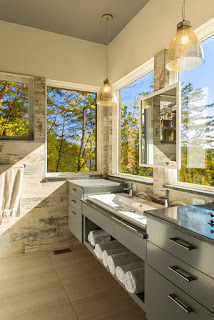Perhaps no term is uttered more frequently, in the world of
windows, than Low-E. By now, most people think they know what that means, but
few know what it means for their home. This is because continued advances in
glazing (glass) technologies allow you, with a little advance planning; select
from different Low-E finishes for different windows in your home. With minimal
effort your budget will go further and you’ll get a more energy efficient home.
 |
| Marvin Windows Gallery |
A Northern Climate
In a nutshell, our northern region climate is dominated by
heating energy use. Our summers can get hot and humid requiring air
conditioning, but heat waves are usually short lived, while winter is cold and
long. It’s a straightforward decision to choose windows with a higher SHGC
(solar heat gain co-efficient), which means the window, will reflect heat back
into the home, collecting more solar heat.
Window Orientation
In addition to our northern climate, you want to consider the
orientation of the windows in your home. Specifying Low-E requirements for
different windows allows you to maximize your home’s comfort and spend your
money wisely. In other words, it’s no longer, one size fits all, and instead Low-E comes in a sophisticated array of options to meet your exact needs.
Here are simple northern region strategies to consider
when planning a remodel or new home.
South facing windows: Choose a high SHGC glazing – above
0.40. South windows are a good source of passive heat in winter, but if you use
this strategy you also need a roof overhang that provides shading in the
summer.
West facing windows:
Choose a low SHGC glazing to reduce much
unwanted afternoon summer heat gain. Overhangs don’t work well against the low
evening sun.
 |
| Marvin Windows Gallery |
East facing windows:
Like west facing windows, keep the size of
these windows to a minimum in order to control unwanted solar gain or loss. Most
people select a low SHGC, however some prefer a high SHGC glazing as a good way
to warm cool mornings.
North facing
windows: Minimal
contribution to the temperature control of your home’s interior.
In closing, once you’ve arrived at your overall requirements,
you can further specify select Low-E options that will reduce fading, increase
your visible light, improving insulating values or lowering condensation
problems, to name just a few.

No comments:
Post a Comment